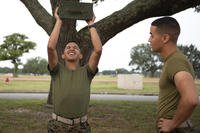Training tactical populations has evolved into a career for many since the Global War on Terrorism began in 2001. Before about 2005, the term "tactical fitness" did not exist. Now it is an integral part of the military's human performance programming that includes everything from job -elated fitness, health and wellness, stress mitigation, nutrition, recovery, injury prevention, and new tactical fitness tests.
The questions below are from a former military member getting into the exercise physiology world and wants to focus on the tactical fitness side of training. Here are my answers to this veteran future trainer or coach:
What makes working with the tactical athlete population different than other types of populations?
Most members in the military do not think of themselves as athletes -- and need to. The terms "tactical fitness" and "tactical athlete" have helped open the eyes of many military members. Combat deployments have increased the need for well-rounded fitness programming.
Educating military members to train like your buddy's life depends on it is critical to success. Most work very hard (high stress) and play harder (additional high stress or reduced recovery processes). Education the tactical athlete on the importance of recovery is even more critical to the active duty (third phase of tactical fitness) than physical training, and most do it wrong. I have been doing TF periodization for 20 years. This is a way to train, not the way to train.
2. What are some of the major challenges and rewards in working with the military and tactical athlete population?
Overall, military members are some of the best people I ever have dealt with, no matter what branch of service or job. Many in the spec ops-level world will prefer the gut check-style training method too often and train on the line of training mental toughness or being stupid and injuring themselves.
But motivation is not needed from me as a coach. My job most of the time is pulling on the reins of overly taxing workouts and adding proper scheduling of recovery and rest days. But seeing them successfully navigate selection programs that typically have 70%-80% attrition rates is a great reward. The only other reward that is better is helping someone who is 100 pounds overweight get within standards and serve their country.
The tactical athlete coach has to understand both ends of the training spectrum. And the coach has to rebuild tactical athletes after injury and guide the military member not to be overly aggressive in starting a program again.
3. Many individuals in the military enjoy exercising and have "self-developed" exercise and training programs or follow popular athletes to meet their personal or professional goals. What are the pros and cons of working with service members that have gone down this path?
As mentioned above, most go too hard and many work only on their current strengths, as no one likes to work on weaknesses. For instance, many will do power-lifting and get really strong mimicking professional lifting workouts, but they neglect cardio. Or many will compete in triathlons and neglect strength. A healthy mix of both is ideal. In the tactical professions, they have to be good at all elements of fitness, not just great at a few and have neglected weaknesses.
Using periodization to focus on the elements of fitness for the tactical athlete must include cycles of strength and power, speed and agility, endurance (run, swim, ruck) and muscle stamina, flexibility and mobility, and grip. Recovery, nutrition and sleep protocols need to be a focus as well.
One final note is to think of tactical fitness as being separated by job-related needs (military, special ops, police, SWAT, fire/EMT) as well as phases of the career. There are three phases you may have to navigate with a tactical athlete:
Phase 1: Candidate/recruit fitness -- Getting to the training (fitness testing)
Phase 2: Getting through boot camp, basic, selection
Phase 3: Active duty -- maintenance/longevity/career
As a trainer, realize that different phases exist and can overlap, depending on the circumstances. Regardless, the profession is challenging but rewarding, and you get to work with some highly motivated people. That can make this one of the easier jobs in the world -- but also one of the more frustrating.
Stew Smith is a former Navy SEAL and fitness author certified as a Strength and Conditioning Specialist (CSCS) with the National Strength and Conditioning Association. Visit his Fitness eBook store if you’re looking to start a workout program to create a healthy lifestyle. Send your fitness questions to stew@stewsmith.com.
Want to Learn More About Military Life?
Whether you're thinking of joining the military, looking for fitness and basic training tips, or keeping up with military life and benefits, Military.com has you covered. Subscribe to Military.com to have military news, updates and resources delivered directly to your inbox.
















